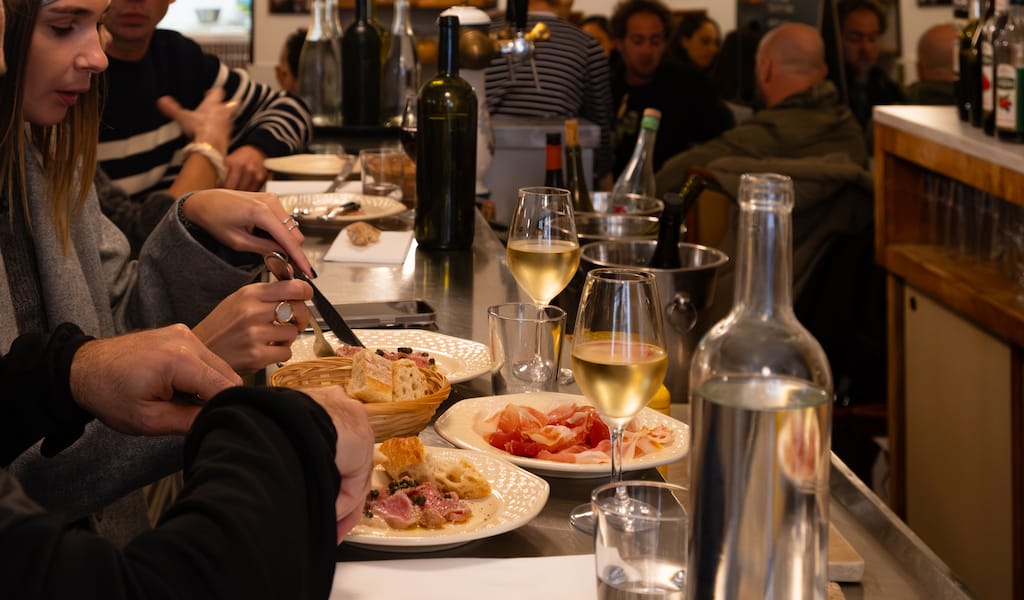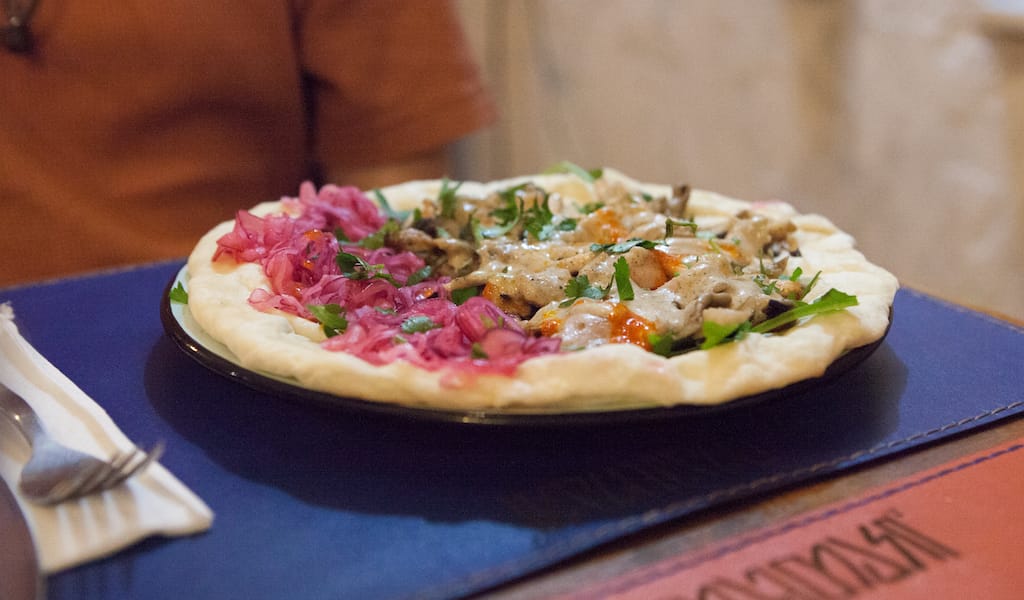The buriti, which grows in wet riversides and swamps, is among the most splendid of South American palms. This tree has special significance in Brazil: it is even an unsuspecting main character in the Brazilian epic novel The Devil to Pay in The Backlands, written by João Guimarães Rosa. For the Guaraní, an indigenous group of the southwest of the country, the buriti palm is a generous being from which each element can be used: fruit, bark, leaves, oil – it’s why its name means “Tree of Life.”
Now, a new Buriti has flourished in Barcelona, just a stone’s throw from the shore in the beachside Poble Nou neighborhood. A Brazilian restaurant full of nostalgic flavors prepared with great skill and served in portions to share tapas-style, but with an authentic Brazilian taste. With dishes like moqueca, acarajé, coixinhas, bobozinho, kibe, amazing fruit caipirinhas, the popular Guaraná Antartica soft drink…like its namesake, Buriti provides a little of everything.
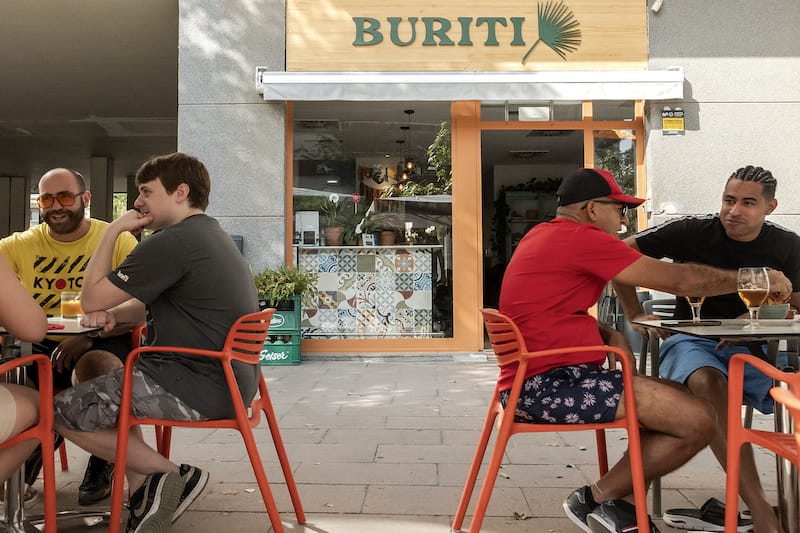
Sara Lemos, owner and head chef, has been running the show at Buriti since March 2023, in the company of Brazilian-French manager David Ferbe. Sara herself is a Bahiana (from the Brazilian state of Bahia) who came to Barcelona in 2007 to study cooking and patisserie at the prestigious Hofmann school, and would go on to work in some of the city’s top restaurants, including Michelin-starred Moments by chef Carme Ruscalleda, the now-closed Roca Moo and the iconic Botafumeiro. After many years of hard work here in Barcelona, a trip back to her hometown proved to be an eye-opening journey, and Sara realized she needed an urgent change. “I was unhappy,” she says. “I felt like I was in the wrong place; I missed so many things [from back home].”
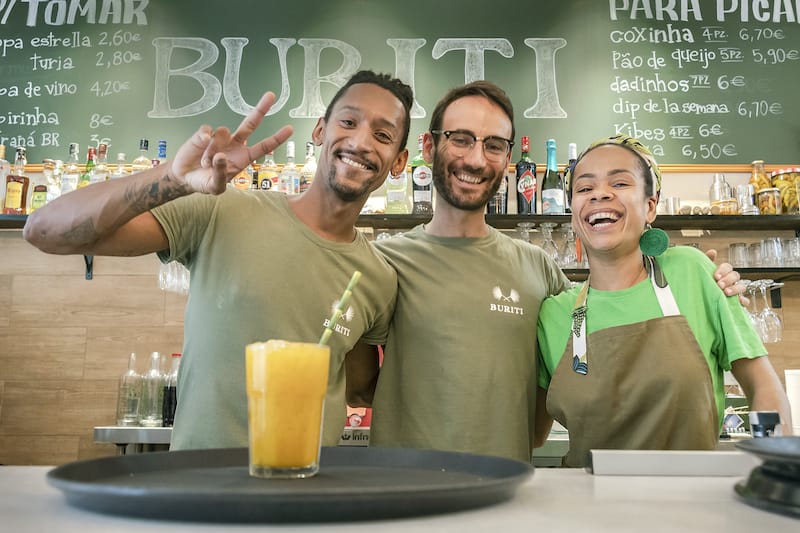
Buriti was born from this need, an important professional and personal leap that Sara was ready to take. “The project comes from the saudade,” she explains, using the hard-to-translate Portuguese term which encompasses longing and nostalgia. “From missing a community, and the food that bring us back to our place in the world. But, especially, [Buriti] came from my interest to take a stance as a migrant woman, as a black woman. And occupy a space that is not [normally occupied by] people with a profile like mine.”
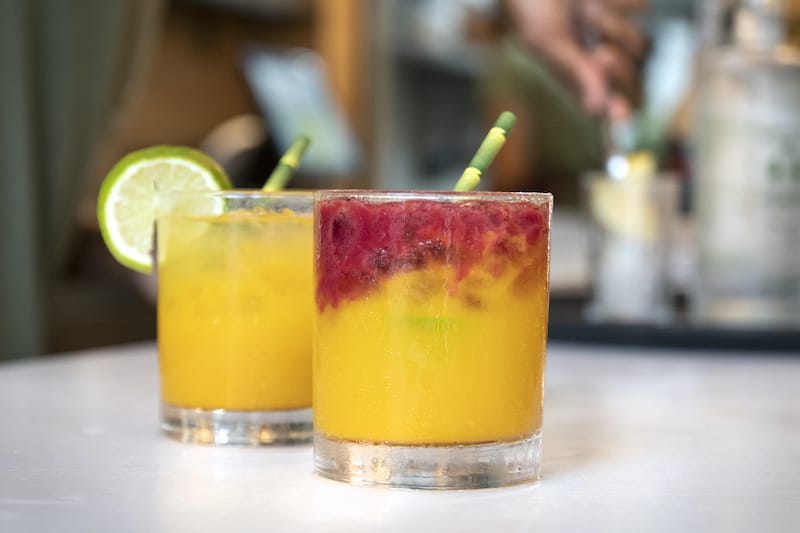
While the Province of Barcelona has a registered population of some fifteen thousand Brazilians, this sizable community has very few good options available to it for authentic food from home. “The Brazilian cuisine in Barcelona or in Spain is too uniform and rigid,” Sara explains, “Always [focused on] the caipirinha, the picanha and the feijoada. But Brazil is much more, with a thousand dishes and techniques!” In fact, in the few months since Buriti’s opening, Sara shares that many Brazilian customers have made the trek from places like Madrid or Valencia, looking for other dishes from home like the acarajé or moqueca. “We want to provide an experience of love, care, memories,” Sara continues. “It is always very exciting! I’m always back and forth from the room to the kitchen and suddenly somebody stops me to hug me, crying, saying that they hadn’t eaten this food for so long. This is what I was looking for, but I never imagined that this would be so intense and happen so fast.”
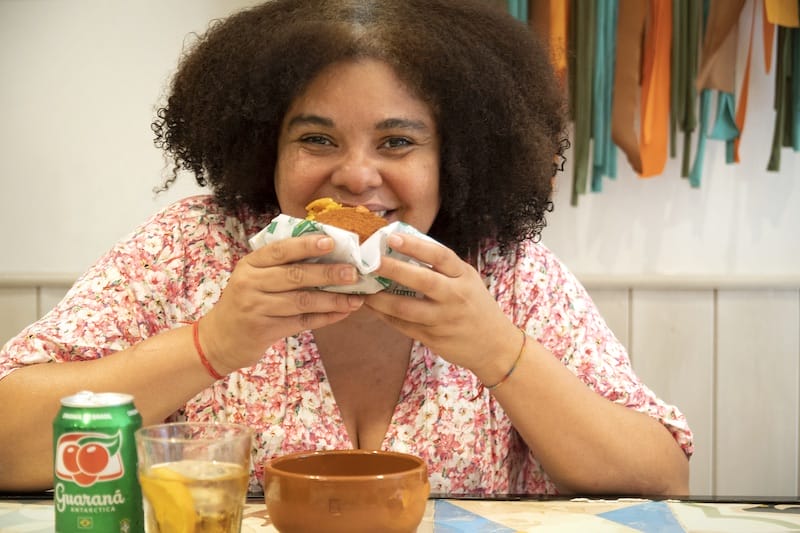
At Buriti, Sara hopes not only to share elevated versions of traditional Brazilian dishes, but also to question the cultural role of haute cuisine. For her “High gastronomy implies looking at the whole picture. [The goal should not be] to make meals more and more exclusive. Buriti is just the opposite. It is food that brings you back to a safe place.” The food at Buriti is always recognizable by any Brazilian customer that drops by. “We try to serve the classic petiscos [snacks] that are common to all of Brazil, because this cuisine is what makes you happiest; it is home, it is genuine. It is true.”
As a Bahiana woman, Sara is committed to represent the African legacy that exists within Brazilian cuisine. After all, of Salvador de Bahía’s three million inhabitants, some 80 percent identify as Afro-descendant, making it the largest Black community outside of Africa. Historically Bahía’s African population was usually on good terms with the Tupí-Guaraní and the food from this region reflects this relationship. “They used to support each other from common dangers, and they learned very quickly to combine the ingredients from both worlds,” Sara explains. This can be seen at Buriti in dishes like the moqueca, acarajé, and bobozinho, with the characteristic touch of dendê oil (a flavorful, red-orange palm oil), coriander or coconut milk.“These dishes represent the African legacy of our cuisine and our sociocultural identity,” says Sara. “An important side of Brazil that is not so visible and which we want to highlight.”
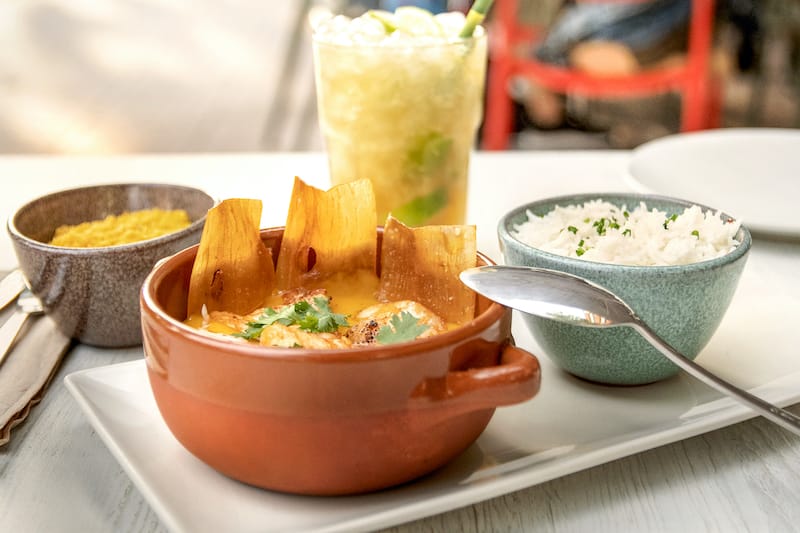
The moqueca is one of the must-try dishes at Buriti, a traditional fish stew that evolved from incorporating African and Portuguese influences into the original Brazilian recipe. The name moqueca may come from the Tupí word moquem, the wood grill used to dry, smoke, or soft-roast the fish (or any meat); or the word pokeka, which refers to a fish dish roasted among tree leaves, according to the writer Luís Câmara Cascudo in his book History of Food in Brazil (1967). Other sources associate the word with mu’keka, meaning “fish casserole” in the Angolan language Kimbundu. In any case, the dish originated with a base of fish and yuca, later incorporating African ingredients like dendê oil and the coconut milk, and elements of traditional Portuguese fish stews like onion and other vegetables – and eventually with the addition of American ingredients such as the tomato.
Another Buriti crowd favorite is the acarajé, an iconic dish of Bahiana cuisine and a distant relative of the Arabic falafel with numerous African variations. Served as a kind of sandwich, it comes on a bun made of a black-eyed pea paste which is then fried in dendê oil until crispy, filled with stir-fried shrimp, cashews and bell pepper and topped with spicy vatapá and carurú sauces. An important cultural symbol, the acarajé has its origin in the traditional akarás, a smaller version of the same dough without any stuffing that means “ball of fire,” offered to the Orixá gods during Afro-Brazilian Candomble rituals. The akarás turned into one of the most popular street foods in Brazil when Bahiana women adapted the recipe, making a bigger size and adding the fillings.
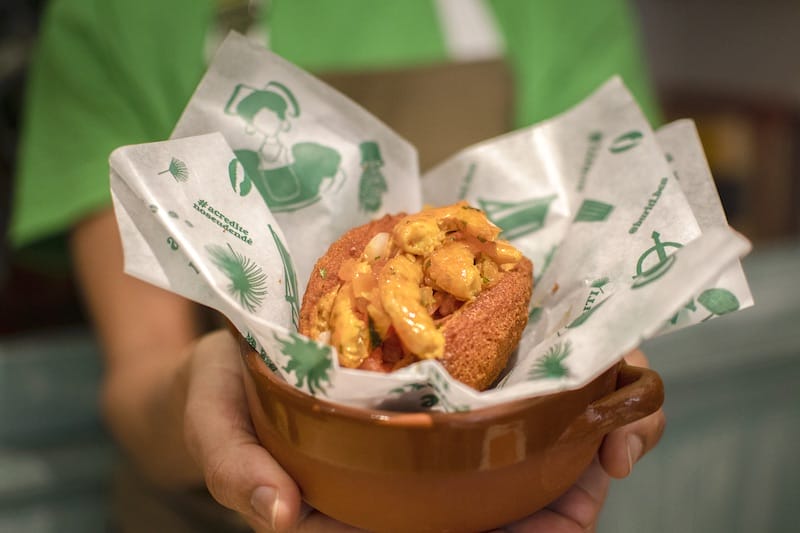
We also love Buriti’s chicken salpicón, a cold salad of juicy roast chicken with fresh apple, lettuce, carrots and walnuts, served with a side of fried yucca; and the aromatic and refreshing “Tropic Tartar” of mango and prawns. Another dish that is unmissable here is the bobozinho. If you show up seriously hungry after a long day of work or hanging at the beach, a good delicious “bobó” is the perfect solution. Another Afro-Brazilian recipe, this stew is made from a yucca cream similar to a potato parmentier combined with, of course, dendê oil, lemony stir-fried shrimp, a sofrito of tomato and onion, and coconut milk, served with one side of white rice and another of farofa (roasted yucca flour).
The idea at Buriti is to integrate, not exclude – so in addition to these Brazilian flavors and favorites are local vermouths and plenty of portions meant for sharing, Spanish-style. Some days, at sunset, a guitar sounds from one of the exterior tables, and a bit of soft, improvised samba or bossa nova is soon joined by voices and laughs. Buriti is becoming a gathering place for the local Brazilian community, drawing close-by neighbors as well as artists, intellectuals, other Brazilian chefs and other activists of feminism and immigration. Catalans and visitors from around the world have also discovered Buriti and added it to their list of local favorites. The Tree of Life has food and shade for all.
 March 19, 2024 À Moro
March 19, 2024 À Moro
In a small dining room with Italian terrazzo floors, warm lighting, and earthy, […] Posted in Marseille March 15, 2024 Tamtaki
March 15, 2024 Tamtaki
The Vera district of Tbilisi is bursting with tempting food options, from traditional […] Posted in Tbilisi March 1, 2024 Pancholi-na
March 1, 2024 Pancholi-na
Last summer, when we first saw handmade posters on the street written in English and […] Posted in Tbilisi
Published on September 08, 2023
Related stories
March 19, 2024
MarseilleIn a small dining room with Italian terrazzo floors, warm lighting, and earthy, distressed walls, every table is occupied. There are regulars from the neighborhood, couples on a quiet afternoon date, a father and small son giggling over pasta, and colleagues sharing plates at a long table in the corner. We grab the only seats…
March 15, 2024
TbilisiThe Vera district of Tbilisi is bursting with tempting food options, from traditional Georgian feasts to cinnamon rolls and pizza. But there is nowhere like Tamtaki in the neighborhood – or anywhere else in Tbilisi, for that matter. Founded by chef Tamta Kikaleishvili and her mother, Katya Gegia, in 2020, the origin of the name…
March 1, 2024
Tbilisi | By Clément Girardot
TbilisiLast summer, when we first saw handmade posters on the street written in English and Georgian announcing the opening of a Japanese bakery, we were both bewildered and excited. On top of many local tone (traditional ovens), Tbilisi had French, German, Turkish and Lithuanian bakeries – but Japanese bread and pastries were unheard of. We…

















































